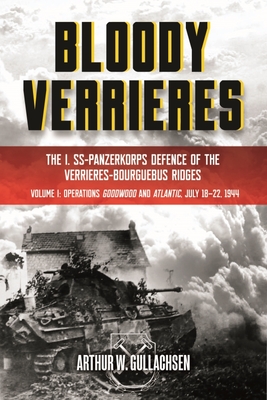Bloody Verrieres: The I. Ss-Panzerkorps Defence of the Verrieres-Bourguebus Ridges: Volume 1 - Operations Goodwood and Atlantic, 18-22 July 1944

Bloody Verrieres: The I. Ss-Panzerkorps Defence of the Verrieres-Bourguebus Ridges: Volume 1 - Operations Goodwood and Atlantic, 18-22 July 1944
Viewed by the German leadership as militarily critical, the majority of its armored assets were deployed to dominate this excellent tank country east of the Orne river. These defeats and the experience of meeting an enemy with near-equal resources exposed a flawed Anglo-Canadian offensive tactical doctrine that was overly dependent on the supremacy of its artillery forces. Furthermore, weaknesses in Allied tank technology inhibited their armored forces from fighting a decisive armored battle, forcing Anglo-Canadian infantry and artillery forces to further rely on First World War "Bite and Hold" tactics, massively supported by artillery. Confronted with the full force of the Panzerwaffe, Anglo-Canadian doctrine at times floundered. In response, the Royal Artillery and Royal Canadian Artillery units pummeled the German tankers and grenadiers, but despite their best efforts, ground could not be captured by concentrated artillery fire alone.
This is a detailed account of the success of I. SS-Panzerkorps' defensive operations, aimed at holding the Vèrrieres-Bourgebus ridges in late July 1944.
PRP: 216.00 Lei
Acesta este Prețul Recomandat de Producător. Prețul de vânzare al produsului este afișat mai jos.
172.80Lei
172.80Lei
216.00 LeiLivrare in 2-4 saptamani
Descrierea produsului
Viewed by the German leadership as militarily critical, the majority of its armored assets were deployed to dominate this excellent tank country east of the Orne river. These defeats and the experience of meeting an enemy with near-equal resources exposed a flawed Anglo-Canadian offensive tactical doctrine that was overly dependent on the supremacy of its artillery forces. Furthermore, weaknesses in Allied tank technology inhibited their armored forces from fighting a decisive armored battle, forcing Anglo-Canadian infantry and artillery forces to further rely on First World War "Bite and Hold" tactics, massively supported by artillery. Confronted with the full force of the Panzerwaffe, Anglo-Canadian doctrine at times floundered. In response, the Royal Artillery and Royal Canadian Artillery units pummeled the German tankers and grenadiers, but despite their best efforts, ground could not be captured by concentrated artillery fire alone.
This is a detailed account of the success of I. SS-Panzerkorps' defensive operations, aimed at holding the Vèrrieres-Bourgebus ridges in late July 1944.
Detaliile produsului









